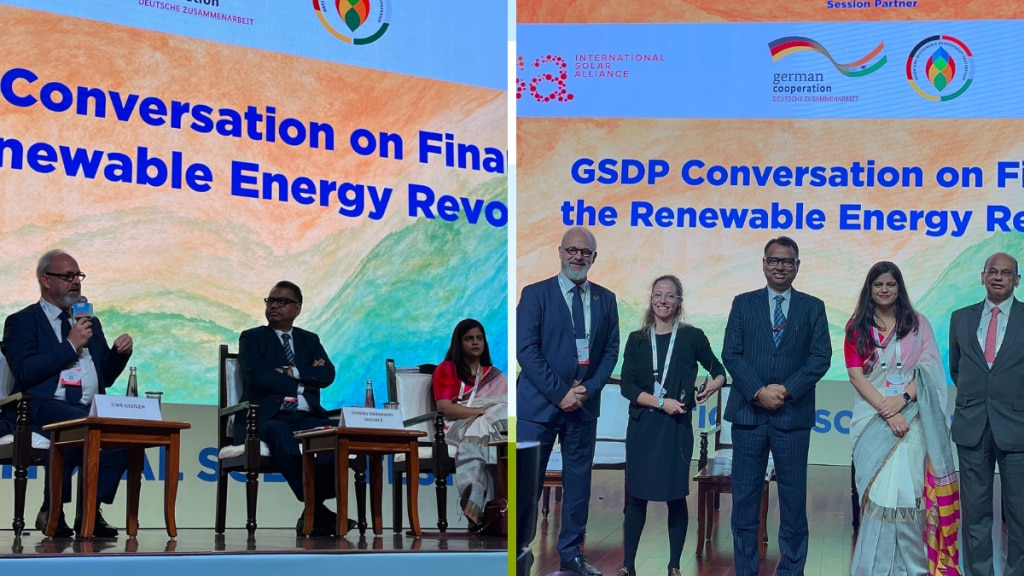India’s renewable energy ambitions are nothing short of revolutionary. With an aggressive target of achieving 500 GW of renewable energy capacity and 125 GW of green hydrogen production by 2030, the nation has placed itself at the forefront of the global clean energy transition. As part of these efforts, at the first International Solar Festival a panel discussion titled “Financing the Renewable Energy Revolution” was held under the Green and Sustainable Development Partnership (GSDP) Conversation Series.
Hosted by the German Embassy, this high-level dialogue featured prominent representatives from India and Germany, along with leaders from international agencies and the private sector, to explore innovative financial solutions and partnerships necessary to achieve India’s ambitious renewable energy goals.
The Indo-German Collaborative Push
India’s renewable energy mission has garnered international attention, especially from Germany, a country with vast expertise in clean energy technologies. Uwe Gehlen, Head of Development Cooperation at the German Embassy, set the tone for the panel by underscoring the significance of a multi-stakeholder approach. “It is indeed not only a financial challenge but also a systemic one,” Gehlen stated, stressing the importance of leveraging existing networks and collaborations across public, private, and international sectors.
Gehlen also stressed the need for an integrated approach that aligns all stakeholders—governments, private entities, and civil society. This collaborative framework is essential for creating a common baseline that fosters transparency and accountability during the transition to renewable energy. His remarks highlighted the need for shared responsibility and long-term vision to achieve net-zero emissions, a goal both India and Germany are committed to.
Germany’s role as the partner country for RE-INVEST 2024, India’s flagship renewable energy investment conference, further signifies its commitment to supporting India’s clean energy transformation. This partnership is poised to unlock much-needed investments and knowledge-sharing platforms between the two nations.
Financing the Renewable Energy Revolution
The conversation quickly pivoted to one of the most pressing challenges: financing. Dr Ajay Mathur, Director General of the International Solar Alliance (ISA), spoke about the sheer scale of investment required to meet India’s renewable energy targets. “The scale of investment required is enormous. More cooperation between India and Germany will unlock funding for mega renewable projects,” Mathur said, adding that such collaborations could provide a major boost to innovative technologies like Agri-Photovoltaics (Agri-PV).
Agri-PV technology, which enables the dual use of land for both agriculture and solar power generation, was highlighted as a promising solution, particularly for large, open spaces like the Thar Desert and the Rann of Kutch. According to Mathur, utilizing these regions could significantly bolster India’s renewable energy output, while also promoting sustainable land use.
Regulatory Support and Corporate Involvement
Shubhangi Kitchloo, Lead at SuperHumanRace, touched on the regulatory frameworks driving corporate sustainability efforts. She pointed to India’s Business Responsibility and Sustainability Reporting (BRSR) framework and Europe’s Corporate Sustainability Reporting Directive (CSRD) as crucial elements that compel companies to prioritize sustainable practices. “But truly scalable solar investment requires dynamic data models that are publicly accessible,” Kitchloo noted, advocating for greater transparency in data sharing to inform corporate investment decisions.
Kitchloo also discussed the role of Agri-PV in rural communities, particularly through corporate social responsibility (CSR) projects. While she acknowledged its success in certain regions, she cautioned that Agri-PV alone would not be sufficient to meet India’s net-zero goals, calling for a more holistic approach that integrates various renewable energy technologies.
India’s Renewable Energy Journey
Dinesh Dayanand Jagdale, Joint Secretary of the Ministry of New and Renewable Energy, provided a comprehensive overview of India’s renewable energy journey. Having already achieved 205 GW of non-fossil fuel capacity, Jagdale reiterated India’s commitment to more than doubling that number by 2030. “This requires not just political commitment but also substantial investment in manufacturing, infrastructure, and human capital,” he said, stressing the need for an all-encompassing strategy that addresses India’s unique geographic and demographic needs.
Jagdale pointed out that India’s approach to renewable energy is multi-faceted, involving not just solar but also bioenergy, waste-to-energy, and solarization of the agricultural sector. He added that India is incentivizing farmers to install solar pumps, a move aimed at reducing dependence on conventional energy sources while promoting agricultural sustainability.
Opportunities for International Cooperation
Throughout the panel discussion, the importance of international cooperation, especially with Germany, was repeatedly emphasized. Gehlen highlighted the potential of financial instruments such as bonds and other innovative mechanisms to bring down the costs of renewable energy projects, making them more accessible and scalable. This would allow countries like India to benefit from German engineering expertise and financial support, accelerating the transition to clean energy.
The panelists also touched upon the critical role of private sector involvement in driving renewable energy expansion. Networking and collaboration between public and private entities, backed by government support, were identified as essential for overcoming financial and technological barriers.
Hybrid Energy Solutions and Future Strategies
One of the key takeaways from the discussion was the growing interest in hybrid energy solutions that combine multiple renewable energy sources, such as solar, wind, and bioenergy. These hybrid models are seen as the future of renewable energy generation, offering greater efficiency, reliability, and scalability compared to single-source solutions.


